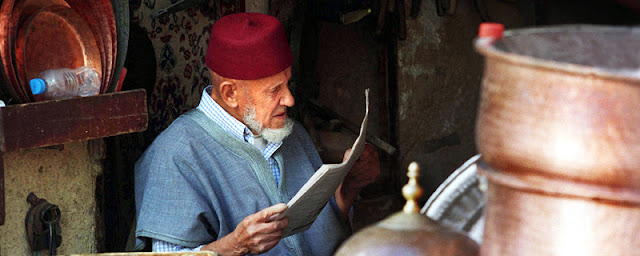The little henna souk (market) is one of the medina's oldest and most picturesque squares, with two massive, gnarled plane trees in the centre and rows of spices, hennas, kohls, and aphrodisiacs for sale in the tiny stalls around the edges. The ceramic shops in the henna souk sell a wide variety of typically blue Fassi pottery
 |
| To find the henna souq, walk down the Talaa Kebira and look out for the sign on your right |
Coming down the Talaa Kebira from Boujloud, locate the sign up on the wall and turn to the right and then immediately left through a small, dark, tunnel-like entrance.
 |
| The entrance to the henna souk |
You will find yourself in a strangely tranquil small square and beneath the huge trees there is what looks like a pile of junk. Look again and you may find some amazing treasures
 |
| Some antiques, some junk... but all interesting |
 |
| Leo Africanus worked here as a young man. It's now a small kissaria (covered market) |
At the square's end is a plaque dedicated to the Maristan Sidi Frej, a medical center and psychiatric and teaching hospital built by the Merenid ruler Youssef Ibn Yakoub in 1286. Used as a model for the world's first mental hospital—founded in Valencia, Spain, in 1410—the Maristan operated until 1944.
This is the perfect place to shop for presents as most of the cosmetics are extremely inexpensive and the shop owners friendly and knowledgeable about traditional products. The rose-oil face cream is popular as are the argan oil soaps. However, the main interest is usually in henna.
 |
| A form of kohl that is crushed and added as glitter beneath the eyes |
 |
| Henna is available pre-mixed or as powder... or even in leaf form |
 |
| Do it yourself? Then start with some leaf henna |
 |
| And if you are not the world's greatest henna artist, stencils are available |
 |
| The stringy bark is "swak" - for a little added dental care! |
 |
| Ghassoul, mixed to a paste is a great body scrub and also good for washing your hair |
 |
| And then there are ceramics... Mohssin Zemmouri can help |
A short history of henna
Henna has been used to adorn young women’s bodies as part of social and holiday celebrations since the late Bronze Age in the eastern Mediterranean. The earliest text mentioning henna in the context of marriage and fertility celebrations comes from the Ugaritic legend of Baal and Anath, which has references to women marking themselves with henna in preparation to meet their husbands, and Anath adorning herself with henna to celebrate a victory over the enemies of Baal.

Wall paintings excavated at Akrotiri (dating prior to the eruption of Thera in 1680 BCE) show women with markings consistent with henna on their nails, palms and soles, in a tableau consistent with the henna bridal description from Ugarit Many statuettes of young women dating between 1500 and 500 BCE along the Mediterranean coastline have raised hands with markings consistent with henna. This early connection between young, fertile women and henna seems to be the origin of the Night of the Henna. The Night of the Henna has spread around the world and is celebrated by most groups in the areas where henna grew naturally: Jews, Muslims, Hindus, Christians and Zoroastrians. All these cultures celebrated marriages by adorning the bride, and often the groom, with henna.
 |
| Walking while the henna dries |
More on henna and a warning about "black henna".
Text and photographs: Sandy McCutcheon
SHARE THIS!



















Wonderfull...thank you, i must have missed the henna souk, although i visited the medina 3 times!
ReplyDeleteNext time i will make sure i will find it.
que bien
ReplyDelete